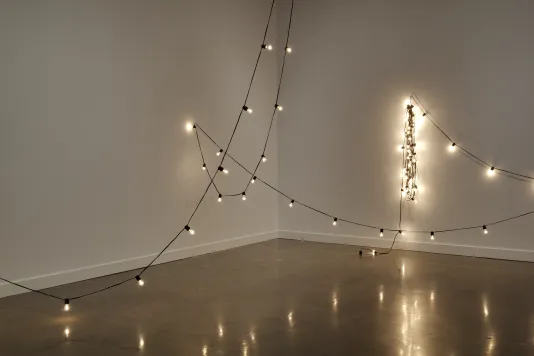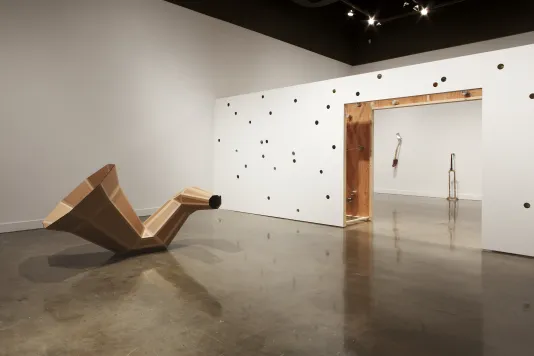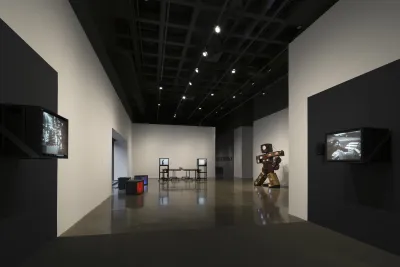Installation view, Amalia Pica, at MIT List Visual Arts Center, 2019
Amalia Pica

The MIT List Visual Arts Center and the Museum of Contemporary Art (MCA) Chicago present Amalia Pica, the artist’s first major solo museum exhibition in the United States. The exhibition provides an in-depth look at the last ten years of this London-based, Argentinian artist’s work.
Using materials such as photocopies, light bulbs, drinking glasses, and cardboard, Amalia Pica (b. 1978, Argentina) confronts the failures, gaps, and slippages of communication. The act of delivering and receiving a verbal or nonverbal message, and the various forms that communicative exchange may take, along with the very limits of language, are central to her work. In Babble Blabber, Chatter, Gibber, Jabber, Patter, Prattle, Rattle, Yammer, Yada yada yada yada (2010) Pica spells out the work’s title using semphore flags. The Catachresis sculptures (2011) are made with objects whose features are referred to metaphorically as parts of the human body, i.e. the tongue of a shoe, the teeth of a saw, the legs of a table, etc. The title of the series is derived from the literary term describing the misapplication of a word or expression to denote something that does not have a name.
The literal and metaphorical figure of the listener is also at the center of much of Pica’s work. In Acoustic Radar in Cardboard (2010-12) Pica reimagines an acoustic locator, the precursor to radar, to “make an image about listening, rather than making a functioning device”. Other works in the exhibition reflect fleeting moments of shared experience, often incorporating the signifiers of celebration and communal gatherings with fiesta lights, bunting, and confetti. Throughout the exhibition performers will enact Strangers (2008) a work where two people who have never met before hold a string of bunting in the exhibition space.
During the exhibition Pica’s nomadic sculpture I am Tower of Hamlets, as I am in Tower of Hamlets, just like a lot of other people are (2011) will be lent to members of the MIT campus community who’ve signed up to take care of the sculpture for one week, then passing it on to the next host. Participants fill out a lending card, which serves as a record of the sculpture’s travels. (For the List Center’s presentation of this work the title will change to reflect the community interaction and location of the artwork.)
Born during Argentina’s dictatorship and so-called “Dirty War”—a seven year campaign against suspected dissidents and subversives—Pica has long ago been interested in the relationship between form and politics, and between history and representation. In Venn Diagrams (under the spotlight) (2011) the artist addresses this period in Argentina when modern mathematics was banned from school programs. Stage (as seen on Afghan Star) (2011) alludes to the Afghan television program for aspiring pop stars; for many voting for their favorite, the show offered a rare public forum for the expression of individual opinion. Pica reflects on how speech is a protected right in some regions of the world, while still a privilege in many others. Surveying the artist’s sculpture, performance, installation, video, and drawing produced over nearly a decade, the exhibition is itself conceived as a conversation among Pica’s works across various mediums.
About the Artist
Amalia Pica received a BA from the Escuela Nacional de Bellas Artes P.P in Buenos Aires in 2003 and attended graduate school at the Rijksakademie van beeldende kunsten in Amsterdam. Pica has had solo exhibitions at Kunst Halle Sankt Gallen (2012), Marc Foxx Gallery, Los Angeles, and Chisenhale Gallery, London (both 2011), and Malmö Konsthall (2010), to name a few. Her work has also been included in numerous group exhibitions such as The Ungovernables at the New Museum (2012), Silence at the Menil Collection (2012), Map Marathonat the Serpentine Gallery (2010), Word Event at the Kunsthalle Basel (2008), and Drawing Typologies at the Stedelijk Museum (2007). One of the most promising artists of her generation, she is a recipient of a CIFO grant from the Cisneros Fontanals Art Foundation, a finalist for the Future Generation Art Prize fro the Pinchuk Foundation, and recently completed an artist-in-residence at the prestigious Headlands Center for the Arts outside of San Francisco.
Amalia Pica is co-organized by the MIT List Visual Arts Center, and the Museum of Contemporary Art Chicago. The exhibition was co-curated by João Ribas, Curator, MIT List Visual Arts Center, and Julie Rodrigues Widholm, Pamela Alper Associate Curator at MCA Chicago. The exhibition opens at the MIT List Visual Arts Center and the exhibition will be on view at the MCA Chicago April 27–August 11, 2013.
In conjunction with the exhibition The MIT List Visual Arts Center and the MCA Chicago have produced an illustrated 124-page scholarly catalogue which includes an interview between exhibition curators João Ribas and Julie Rodrigues Widholm, and Amalia Pica, a bibliography and exhibition history of the artist, and images of her work. The publication also includes essays on Pica’s work written by Tirdad Zolghadr, a writer and curator who teaches at the Center for Curatorial Studies, Bard College, NY, and Ana Teixeira Pinto, lecturer at Humboldt University (Berlin) and Mousse Magazine contributor.
Sponsors
Support for the exhibition presented at the MIT List Visual Arts Center has been generously provided by the Barbara Lee Family Foundation, the Council for the Arts at MIT, the Massachusetts Cultural Council, the Office of the Associate Provost at MIT, the MIT List Visual Arts Center Advisory Committee, and the Friends of the List.















